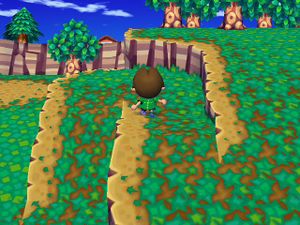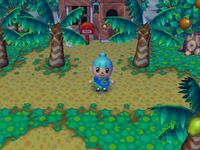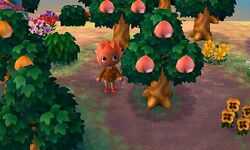Animal tracks

Animal tracks[1] are an environmental feature occurring in both Animal Crossing: City Folk and Animal Crossing: New Leaf where the grass in the player's town slowly wears over time due to walking or running over an area repeatedly.
Appearances[edit]
In City Folk[edit]
Animal tracks are more visible in Animal Crossing: City Folk than they are in New Leaf, so much so that in City Folk, the grass beneath the player's feet will wear down just by walking. Over time, the grass in the player's town will grow back, with the rate of regrowth being mostly stable across all seasons, with some slight variation. For example, in the winter months, grass deterioration is much faster. But in the spring and summer months, the grass becomes more resilient.
Game mechanics[edit]
Each grass tile has a health value ranging from 0–255, with 0 being entirely dirt and 255 being completely healthy. The first time the player walks across a grass tile (per game load), the grass's health value will decrease between 4-11 points, depending on the season. At the beginning of a new day at 6AM, the game restores up to 9 health points for each grass tile, with the exact number being dependent on the amount of flora inhabiting the space as well as the tile's proximity to other healthy (or unhealthy) tiles.
Factors influencing grass wear[edit]
The most noticeable increase in wear occurs with the changing of the seasons. The following table illustrates the difference in deterioration rates per tile after one round of wear. Notice the sharp increase in wear during winter.
| 4-7 health points lost | 4-8 health points lost | 4-9 health points lost | 8-11 health points lost |
The first time a player steps on a grass tile (per game load) the game selects a value within the appropriate range for the current season, and subtracts it from the tile's health value. A new round of wear can occur each time the town is loaded from memory. In addition to the initial game start, this occurs when partying over a Wi-Fi game, coming back from a friend's town, and by the start of the day message at 6 AM.
- Factors that do not affect grass wear: Contrary to common belief, running over grass tiles instead of walking over them will not increase the rate at which the grass tile loses health points; however, it does increase the likelihood of the player stepping on a greater number of grass tiles, giving the illusion that the grass is decaying more quickly. Additionally, the number of times a player walks over a space during the same game session is not considered by the game code, however this again increases the likelihood of walking over the neighboring tiles of damaged grass tiles in high traffic areas, again creating this illusion. Whether or not a custom design pattern has been placed over a grass tile has no effect to its rate of decay.
Factors influencing grass regrowth[edit]
The player can manipulate grass regrowth to an extent. Certain flora speed up regrowth, while others have no effect. The effects noted in the table below are mitigated by a tile's proximity to other unhealthy tiles. If a tile is surrounded by healthy tiles, the effects will be maximized; otherwise the grass will regrow more slowly. The game adjusts the health of all grass tiles at the beginning of each day (6AM).
| Standard Growth (Empty Tile) | Flower | Tree | Stump | Sapling | Near Unhealthy Tile(s) |
|---|---|---|---|---|---|
| 4 health points gained | 5 extra health points | 5 extra health points | 5 extra health points | 5 extra health points | 1 fewer health points gained |
By providing five extra health points, flowers and trees can provide a total of up to nine health points per day. Note though that they only provide a growth bonus to the space they are occupying. Proximity to unhealthy spaces subtracts from the base growth rate, meaning that a grass tile with nothing on it would only gain three points of growth per day. As the minimum wear rate is -4, continually walking on a bare spot of grass makes it impossible for it to regrow.
- Factors that do not affect grass growth: The presence of a weed, dropped item, buried item, or pattern. Watering flowers (or even unoccupied tiles) and precipitation do not have an effect on regrowth. The type of flower or tree does not matter; all provide five bonus points.
In New Leaf[edit]
Grass deterioration is much more subtle in New Leaf and frequently traversed areas require extensive use before the grass begins to fade. That being said, some players have reported extensive wear to the point of desertification. The addition of public works projects has also contributed to this process, as a patch of dirt is created when the player sets up an area for donations, as well as when a public works project has finished construction. In this instance, only a small amount of wear is visible around the completed project. The true size of the dirt patch becomes apparent if the player opts to demolish the project, with the severity of grass wear being dependent on the amount of tiles the finished project occupies.
In addition to grass deterioration caused by public works projects, other factors can contribute. Villagers moving in and placing down their plot from Nook's Homes erodes all grass previously occupying their plot, again becoming less visible when they move in the following day, but full visibility returns when the villager leaves the player's town. Slight deterioration is also visible around the edges of river's in the player's town.
While the exact wear and regrowth mechanics are unknown, the feature is thought to operate much as it did in Animal Crossing: City Folk.
Observed changes[edit]
- The game no longer allows additional rounds of grass wear each time the game is loaded.
- Grass regrowth is improved by three stages the day after a snow event and by one stage the day after a rain event.
Further details: More info on the effects of weather and the updated wear/regrowth ratio is needed.
Further details: More info on the effects of weather and the updated wear/regrowth ratio is needed.
Regrowth[edit]
Complete regrowth from dirt to full health can take between 1-3 months to achieve depending on the extent of the damage and the factors influencing growth. There are a few ways in which a player can aid this process. Planting trees and flowers in the trampled area will speed up regrowth significantly. Using the growth rates from Animal Crossing: City Folk, assuming a grass health of zero, an isolated patch of dirt can achieve full health in 29 days (256/9=28.4...). Trees provide an additional advantage in that they serve as a physical barrier to prevent players from inadvertently stepping on worn areas and do not need to be watered. At the same time, their growth is limited by proximity and count restrictions which do not apply to flowers.
Once the trees and flowers are planted, the player must avoid walking in the affected area other than to keep the flowers watered. For players who are willing to time travel within the game, the regrowth process can be further accelerated by advancing the game clock forward one day at a time, being certain that all flowers are kept watered each day. Setting the game clock backward in time or moving forward more than one day does not result in additional grass regrowth. The player can take advantage of seasonal weather changes in Animal Crossing: New Leaf and load their game in winter when it snows, or in the other seasons when it rains, allowing for a faster regeneration rate.
Gallery[edit]
References[edit]
- ↑ Nintendo. "Iwata Asks | 2. Animal Tracks in Animal Crossing?". Retrieved November 11, 2020.
Further details: Poor writing, needs to be less guide-like.
Further details: Poor writing, needs to be less guide-like.
| Gameplay elements | ||||||||||||||||||||||||||
|---|---|---|---|---|---|---|---|---|---|---|---|---|---|---|---|---|---|---|---|---|---|---|---|---|---|---|
| ||||||||||||||||||||||||||
| Flora | ||||||||||||||||
|---|---|---|---|---|---|---|---|---|---|---|---|---|---|---|---|---|
| ||||||||||||||||







